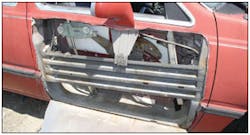Opening a Jammed Door
Deactivation of the safety lock-and-latch mechanism is a simple, but effective technique for opening jammed doors that all rescue personnel should be familiar with. This evolution can be considered an alternative, backup technique to forcing a door with power rescue tools, or it can become the primary attack evolution when power rescue equipment is not available.
To set up for the lock-and-latch deactivation evolution, personnel use either air-powered or manual metal-cutting equipment to make a large opening in the outer skin of the damaged door. The opening should begin above the door handle, proceed forward across the top portion of the door for a distance equal to at least half the length of the door, continue vertically down the door halfway and return to the latch edge of the door. Using the door handle, the cut metal section is pulled open. This large, three-sided cut of at least 16 by 16 inches allows this portion of the door skin to be folded outward and toward the rear.
With the flap of door skin folded out of the way, the inner workings of the door are exposed behind the door collision beam. Along the latch end of the door is the safety lock and latch assembly. It is slightly larger than a pack of cigarettes. Several rods will be connected to this box.
An air chisel with a long, flat chisel bit or simple manual tools such as a tire iron, Halligan bar or large flat-blade screwdriver are then used to begin prying the top of the latch mechanism cover off the safety lock and latch box. Do not cut the latch assembly off the door; simply take the latch box apart!
Once the cover plate is bent forward or removed completely, the inner cogs of the latch assembly become more visible. The deactivation technique continues as the two or three small metal latch cogs inside this door mechanism are manually pried apart from each other. They normally overlap each other by only a quarter-inch. Simply bending, moving or removing one or more of the cogs will cause the safety latch mechanism to release its grip on the Nader safety pin and the door will "pop."
Once these cogs are freed and the door releases, the 4,000-pound-capacity safety lock and latch have been deactivated. If the door doesn't open at this point, it can be easily pried open with simple hand tools at any point where it might still be bent or jammed.
When done by a trained crew of two people, the total door deactivation evolution can be accomplished in 90 seconds or less.
Ronald E. Moore, a Firehouse® contributing editor, is a battalion chief and the training officer for the McKinney, TX, Fire Department. He also authors a monthly online article in the Firehouse.com "MembersZone" and serves as the Forum Moderator for the extrication section of the Firehouse.com website. Moore can be contacted directly at [email protected].
